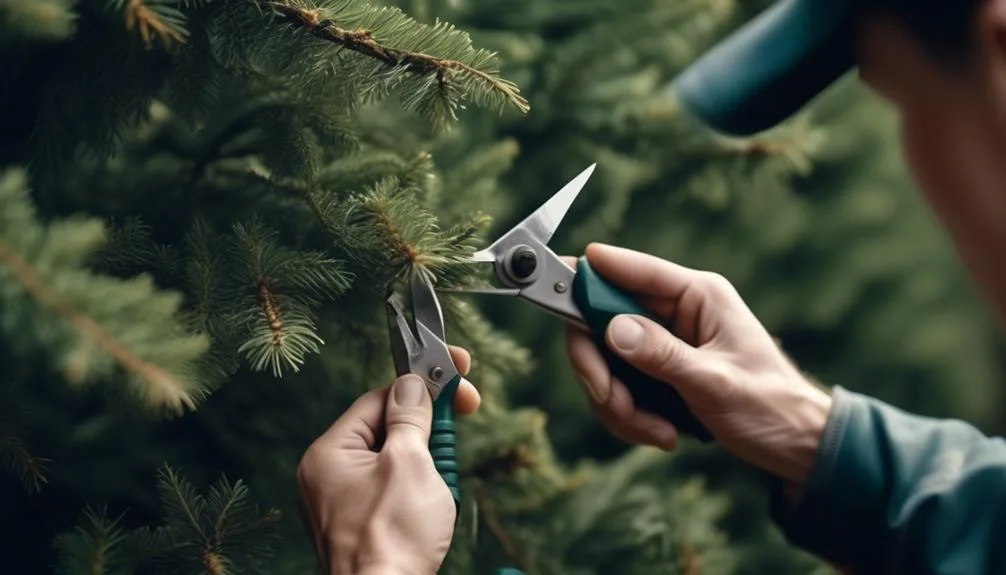Pruning spruce trees is essential for their optimal growth. By understanding the right techniques and timing for pruning, you can shape their growth effectively. It's like sculpting a masterpiece, where each snip and trim plays a crucial role.
These majestic trees have the potential to become even more impressive with proper care. So, let's explore the art of pruning spruce trees and uncover the secrets to nurturing their vitality and beauty.
Understanding Spruce Tree Growth Patterns
To understand spruce tree growth patterns, observe the annual growth rings visible on the trunk and branches, which can provide valuable insights into the tree's development and health. These rings indicate the rate of growth and can reveal periods of stress, such as drought or disease. Understanding these patterns is crucial for implementing effective pruning strategies.
Pruning benefits the overall health and appearance of spruce trees by promoting air circulation, reducing the risk of disease, and shaping the tree's growth. Additionally, it's essential to identify and address any growth inhibitors, such as competing branches or excessive foliage, to ensure the tree's optimal development.
Identifying the Best Time to Prune
As you observe the annual growth rings on your spruce tree, you can determine the best time for pruning to promote its optimal development and overall health. Understanding the growth stages of your spruce tree is crucial in identifying the ideal pruning timing.
Typically, the best time to prune spruce trees is late winter to early spring, while the tree is still dormant. This period allows for the tree to recover from pruning before the active growth phase begins.
Avoid pruning during the fall as it may lead to new growth that can be easily damaged by winter weather. Additionally, refrain from pruning during the summer months when the tree is actively growing, as this can cause undue stress.
Essential Tools for Pruning Spruce Trees
When pruning spruce trees, selecting the right tools is essential to ensure clean cuts and minimize stress on the tree. Here are the essential tools you need for pruning spruce trees:
- Pruning Shears: Also known as hand pruners, these are essential for removing small branches and twigs. Look for a sharp, bypass-style pruner to make clean cuts without crushing the stems.
- Loppers: For thicker branches, loppers with long handles provide the leverage needed to make clean cuts. Look for ones with sharp blades and a gear or ratchet mechanism to make cutting easier.
- Pruning Saw: A pruning saw is essential for larger branches. Look for a curved blade design with sharp teeth to make quick and clean cuts.
Selecting the right tools is crucial for effective pruning techniques and maintaining the health and aesthetic appeal of your spruce trees.
Techniques for Shaping Spruce Trees
Selecting the right tools for shaping spruce trees is crucial for effective pruning techniques and maintaining the health and aesthetic appeal of your trees.
When shaping spruce trees, it's important to focus on enhancing the branch structure to promote a balanced and visually appealing form. Start by identifying any crowded or crossing branches that may hinder the tree's growth or affect its overall aesthetic appeal.
Use pruning shears to carefully remove these problematic branches, ensuring that the natural shape of the tree is maintained. Additionally, consider using hand pruners for smaller branches and a pruning saw for larger ones to achieve the desired shape.
Maintaining Healthy Growth After Pruning
To maintain healthy growth after pruning, it's essential to monitor the tree for any signs of stress or disease while providing proper care and maintenance. Here are key steps to ensure optimal growth:
- Pruning Frequency: After the initial pruning, regularly inspect the tree for any new growth that may need shaping. Typically, spruce trees require light pruning annually to maintain their shape and encourage healthy growth.
- Fertilization Schedule: Implement a regular fertilization schedule to provide essential nutrients for the tree's recovery and ongoing growth. Apply a balanced fertilizer in early spring before new growth begins to support healthy foliage and overall vitality.
- Monitoring and Care: Regularly check for any signs of stress, disease, or pest infestations. Address any issues promptly to prevent them from affecting the tree's growth and overall health. Regular watering and mulching can also aid in maintaining optimal growth post-pruning.
Conclusion
Pruning spruce trees is a crucial step in promoting healthy growth and maintaining their shape. By understanding their growth patterns and using the right tools and techniques, you can ensure optimal growth for your spruce trees.
Remember to prune at the right time and monitor their health post-pruning to support their ongoing growth and vitality. With proper care, your spruce trees will thrive and enhance the beauty of your landscape for years to come.
Consider the long-term benefits of regular pruning for the overall health and aesthetics of your trees.

My interest in trees started when I first saw the giant sequoias in Yosemite.
I was a teenager then, and I remember thinking, “I need to learn more about this.”
That moment stuck with me.
A few years later, I went on to study forestry at Michigan Tech.
Since graduating, I’ve worked in a mix of hands-on tree care and community education.
I’ve spent over ten years helping people understand how to plant, maintain, and protect the trees in their neighborhoods.
I don’t see trees as just part of the landscape.
They are living things that make a real difference in our daily lives.
